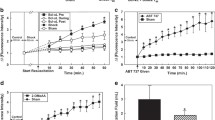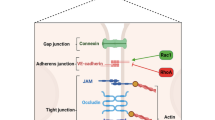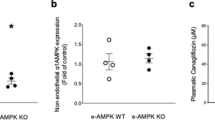Abstract
Hemorrhagic shock leads to endothelial cell barrier dysfunction resulting in microvascular hyperpermeability. Hemorrhagic shock-induced microvascular hyperpermeability is associated with worse clinical outcomes in patients with traumatic injuries. The results from our laboratory have illustrated a possible pathophysiological mechanism showing involvement of mitochondria-mediated “intrinsic” apoptotic signaling in regulating hemorrhagic shock-induced microvascular hyperpermeability. Hemorrhagic shock results in overexpression of Bcl-2 family of pro-apoptotic protein, BAK, in the microvascular endothelial cells. The increase in BAK initiates “intrinsic” apoptotic signaling cascade with the release of mitochondrial cytochrome c in the cytoplasm and activation of downstream effector caspase-3, leading to loss of endothelial cell barrier integrity. Thus, this review article offers a brief overview of important findings from our past and present research work along with new leads for future research. The summary of our research work will provide information leading to different avenues in developing novel strategies against microvascular hyperpermeability following hemorrhagic shock.

Similar content being viewed by others
References
Childs, E. W., Udobi, K. F., Hunter, F. A., & Dhevan, V. (2005). Evidence of transcellular albumin transport after hemorrhagic shock. Shock, 23, 565–570.
Dewar, D., Moore, F. A., Moore, E. E., & Balogh, Z. (2009). Postinjury multiple organ failure. Injury, 40, 912–918.
World Health Organization International Injuries [Internet]. Available from: http://www.who.int/topics/injuries/about/en/index.html.
North Dakota Health.gov Trauma Statistics [Internet]. Available from: http://www.ndhealth.gov/trauma/stats.
National Trauma Institute.org Trauma Statistics [Internet]. Available from: http://www.nationaltraumainstitute.org/home/trauma_statistics.html.
Yuan, S. Y., & Rigor, R. R. (2010). Regulation of endothelial barrier function. In: Colloquium series on integrated systems physiology: from molecule to function to disease. San Rafael: Morgan & Claypool Life Sciences.
Vandenbroucke, E., Mehta, D., Minshall, R., & Malik, A. B. (2008). Regulation of endothelial junctional permeability. Annals New York Academy Science, 1123, 134–145.
Mehta, D., & Malik, A. B. (2006). Signaling mechanisms regulating endothelial permeability. Physiological Reviews, 86, 279–367.
Minshall, R. D., Sessa, W. C., Stan, R. V., Anderson, R. G., & Malik, A. B. (2003). Caveolin regulation of endothelial function. American Journal of Physiology. Lung Cellular and Molecular Physiology, 285, L1179–1183.
Simionescu, N., Simonionescu, M., & Palade, G. E. (1978). Open junctions in the endothelium of the postcapillary venules of the diaphragm. Journal of Cell Biology, 79, 27–44.
Niessen, C. M. (2007). Tight junctions/adherens junctions: basic structure and function. Journal of Investigative Dermatology, 127, 2525–2532.
Gianfranco, B., & Dejana, E. (2008). Endothelial cell-to-cell junctions: molecular organization and role in vascular homeostasis. Physiological Reviews, 84, 869–901.
Lampugnani, M. G., et al. (1995). The molecular organization of endothelial cell to cell junctions: differential association of plakoglobin, beta-catenin, and alpha-catenin with vascular endothelial cadherin (VE-cadherin). Journal of Cell Biology, 129, 203–217.
Hartsock, A., & Nelson, W. J. (2008). Adherens and tight junctions: structure, function and connections to the actin cytoskeleton. Biochimica et Biophysica Acta, 1778, 660–669.
Kanlaya, R., Pattanakitsakul, S. N., Sinchaikul, S., Chen, S. T., & Thongboonkerd, V. (2009). Alterations in actin cytoskeletal assembly and junctional protein complexes in human endothelial cells induced by dengue virus infection and mimicry of leukocyte transendothelial migration. Journal of Proteome Research, 8, 2551–2262.
Fulda, S., & Debatin, K. M. (2006). Extrinsic versus intrinsic apoptosis pathways in anticancer chemotherapy. Oncogene, 25, 4798–4811.
Hotchkiss, R. S., Strasser, A., McDunn, J. E., & Swanson, P. E. (2009). Cell death. New England Journal of Medicine, 361, 1570–1583.
Dejana, E., Spagnuolo, R., & Bazzoni, G. (2001). Interendothelial junctions and their role in the control of angiogenesis, vascular permeability and leukocyte transmigration. Thrombosis and Haemostasis, 86, 308–315.
Dejana, E., Orsenigo, F., & Lampugnani, M. G. (2008). The role of adherens junctions and VE-cadherin in the control of vascular permeability. Journal of Cell Science, 121, 2115–2122.
Childs, E. W., Tharakan, B., Hunter, F. A., Tinsley, J. H., & Cao, X. (2007). Apoptotic signaling induces hyperpermeability following hemorrhagic shock. American Journal of Physiology Heart and Circulatory Physiology, 292, H3179–H3189.
Moffitt, K. L., Martin, S. L., & Walker, B. (2010). From sentencing to execution—the processes of apoptosis. Journal of Pharmacy and Pharmacology, 62, 547–562.
Galluzzi, L., Blomgren, K., & Kroemer, G. (2009). Mitochondrial membrane permeabilization in neuronal injury. Nature Review Neuroscience, 10, 481–494.
Childs, E. W., Tharakan, B., Hunter, F. A., Isong, M., & Liggins, N. D. (2008). Mitochondrial complex III is involved in proapoptotic BAK-induced microvascular endothelial cell hyperpermeability. Shock, 29, 636–641.
Roumen, R. M., Hendriks, T., van der Ven-Jongekrijg, J., Nieuwenhuijzen, G. A., Sauerwein, R. W., van der Meer, J. W., & Gori, R. J. (1993). Cytokine patterns in patients after major vascular surgery, hemorrhagic shock, and severe blunt trauma. Relation with subsequent adult respiratory distress syndrome and multiple organ failure. Annals of Surgery, 218, 769–776.
Sawant, D. A., Tharakan, B., Wilson, R. L., Stagg, H. W., Hunter, F. A., & Childs, E. W. (2013). Regulation of tumor necrosis factor-α-induced microvascular endothelial cell hyperpermeability by recombinant B-cell lymphoma-extra large. Journal of Surgical Research, 184(1), 628–37.
Petrache, I., Verin, A. D., Crow, M. T., et al. (2001). Differential effect of MLC kinase in TNF-alpha-induced endothelial cell apoptosis and barrier dysfunction. American Journal of Physiology. Lung Cellular and Molecular Physiology, 280, L1168–1178.
Petrache, I., Birukova, A., Ramirez, S. I., et al. (2003). The role of the microtubules in tumor necrosis factor-alpha-induced endothelial cell permeability. American Journal of Respiratory Cell and Molecular Biology, 28, 574–581.
Goldblum, S. E., Hennig, B., Jay, M., et al. (1989). Tumor necrosis factor alpha-induced pulmonary vascular endothelial injury. Infection and Immunity, 57, 1218–1226.
Campbell, M. T., Dagher, P., Hile, K. L., et al. (2008). Tumor necrosis factor-α induces intrinsic apoptotic signaling during renal obstruction through truncated Bid activation. Journal of Urology, 180, 2694–2700.
Sawant, D. A., Tharakan, B., Tobin, R. P., Stagg, H. W., Hunter, F. A., Newell, M. K., Smythe, W. R., & Childs, E. W. (2013). Inhibition of Fas-Fas ligand interaction attenuates microvascular hyperpermeability following hemorrhagic shock. Shock, 39, 161–167.
Reap, E. A., Roof, K., Maynor, K., Borrero, M., Booker, J., & Cohen, P. L. (1997). Radiation and stress-induced apoptosis: a role for Fas/Fas ligand interactions. Proceedings of the National Academy of Science, 94, 5750–5755.
Sawant, D. A., Tharakan, B., Tobin, R. P., Reilly, J., Hunter, F. A., Newell, M. K., Smythe, W. R., & Childs, E. W. (2013). Microvascular endothelial cell hyperpermeability induced by endogenous caspase 3 activator staurosporine. Journal Trauma Acute Care Surgery, 74, 516–523.
Childs, E. W., Tharakan, B., Byrge, N., Tinsley, J. H., Hunter, F. A., & Smythe, W. R. (2008). Angiopoietin-1 inhibits intrinsic apoptotic signaling and vascular hyperpermeability following hemorrhagic shock. American Journal of Physiology Heart and Circulatory Physiology, 294, H2285–H2295.
Gamble, J. R., Drew, J., Trezise, L., Underwood, A., Parsons, M., Kasminkas, L., Rudge, J., Yancopoulos, G., & Vadas, M. A. (2000). Angiopoietin-1 is an antipermeability and anti-inflammatory agent in vitro and targets cell junctions. Circulation Research, 87, 603–607.
Tharakan, B., Hunter, F. A., Smythe, W. R., & Childs, E. W. (2008). Alpha-lipoic acid attenuates hemorrhagic shock-induced apoptotic signaling and vascular hyperpermeability. Shock, 30, 571–577.
Eremeeva, M. E., & Silverman, D. J. (1998). Effects of the antioxidant alpha-lipoic acid on human umbilical vein endothelial cells infected with Rickettsia rickettsii. Infection and Immunity, 66, 2290–2299.
Ola, M. S., Nawaz, M., & Ahsan, H. (2011). Role of Bcl-2 family proteins and caspases in the regulation of apoptosis. Molecular and Cellular Biochemistry, 351, 41–58.
Distelhorst, C. W., & Bootman, M. D. (2011). Bcl-2 interaction with the inositol 1,4,5-trisphosphate receptor: role in Ca (2+) signaling and disease. Cell Calcium, 50(3), 234–241.
Tornero, D., Posadas, I., & Ceña, V. (2011). Bcl-x (L) blocks a mitochondrial inner membrane channel and prevents Ca2+ overload-mediated cell death. PloS One, 6, e20423.
Childs, E. W., Tharakan, B., Nurudeen, S., Delmas, T. L., Hellman, J., Christie, T., Hunter, F. A., & Smythe, W. R. (2010). Cyclosporine a—protection against microvascular hyperpermeability is calcineurin independent. American Journal of Surgery, 199, 542–548.
Crabtree, G. R. (2001). Calcium, calcineurin, and the control of transcription. Journal of Biological Chemistry, 276, 2313–2316.
Armstrong, J. S., Yang, H., Duan, W., & Whiteman, M. (2004). Cytochrome bc (1) regulates the mitochondrial permeability transition by two distinct pathways. Journal of Biological Chemistry, 279, 50420–50428.
Tharakan, B., Hunter, F. A., Smythe, W. R., & Childs, E. W. (2010). Curcumin inhibits reactive oxygen species formation and vascular hyperpermeability following haemorrhagic shock. Clinical and Experimental Pharmacology and Physiology, 37, 939–944.
Teiten, M. H., Gaigneaux, A., Chateauvieux, S., Billing, A. M., Planchon, S., Fack, F., Renaut, J., Mack, F., Muller, C. P., Dicato, M., & Diederich, M. (2012). Identification of differentially expressed proteins in curcumin-treated prostate cancer cell lines. OMICS, 16, 289–300.
Childs, E. W., Tharakan, B., Hunter, F. A., & Smythe, W. R. (2010). 17beta-estradiol mediated protection against vascular leak after hemorrhagic shock: role of estrogen receptors and apoptotic signaling. Shock, 34, 229–235.
Kawasaki, T., & Chaudry, I. H. (2012). The effects of estrogen on various organs: therapeutic approach for sepsis, trauma, and reperfusion injury. Part 1: central nervous system, lung, and heart. Journal of Anesthesia, 26, 883–891.
Harris, E. S., & Nelson, W. J. (2010). VE-cadherin: at the front, center, and sides of endothelial cell organization and function. Current Opinion in Cell Biology, 22, 651–658.
Dejana, E., Taddei, A., & Randi, A. M. (2007). Foxs and Ets in the transcriptional regulation of endothelial cell differentiation and angiogenesis. Biochimica et Biophysica Acta, 1775, 298–312.
Furuyama, T., Kitayama, K., Shimoda, Y., Ogawa, M., Sone, K., Yoshida-Araki, K., Hisatsune, H., Nishikawa, S., Nakayama, K., Ikeda, K., Motoyama, N., & Mori, N. (2004). Abnormal angiogenesis in Foxo1 (Fkhr)-deficient mice. Journal of Biological Chemistry, 279, 34741–34749.
Taddei, A., Giampietro, C., Conti, A., Orsenigo, F., Breviario, F., Pirazzoli, V., Potente, M., Daly, C., Dimmeler, S., & Dejana, E. (2008). Endothelial adherens junctions control tight junctions by VE-cadherin-mediated upregulation of claudin-5. Nature Cell Biology, 10, 923–934.
Steinhusen, U., Badock, V., Baurer, A., Behrens, J., Wittman-Liebold, B., Dörken, B., & Bommert, K. (2000). Apoptosis-induced cleavage of beta-catenin by caspase-3 results in proteolytic fragments with reduced transactivation potential. Journal of Biological Chemistry, 275, 16345–16353.
Hinck, L., Näthke, I. S., Papkoff, J., & Nelson, W. J. (1994). Dynamics of cadherin/catenin complex formation: novel protein interactions and pathways of complex assembly. The Journal of Cell Biology, 125, 1327–1340.
Lilien, J., & Balsamo, J. (2005). The regulation of cadherin-mediated adhesion by tyrosine phosphorylation/dephosphorylation of beta-catenin. Current Opinion in Cell Biology, 17, 459–465.
Miller, J. R., Hocking, A. M., Brown, J. D., & Moon, R. T. (1999). Mechanism and function of signal transduction by the Wnt/beta-catenin and Wnt/Ca2+ pathways. Oncogene, 18, 7860–7872.
Novak, A., & Dedhar, S. (1999). Signaling through beta-catenin and Lef/Tcf. Cellular and Molecular Life Sciences, 56, 523–537.
Dejana, E. (2010). The role of wnt signaling in physiological and pathological angiogenesis. Circulation Research, 107, 943–952.
Davidson, S. M., & Duchen, M. R. (2007). Endothelial mitochondria: contributing to vascular function and disease. Circulation Research, 100, 1128–1141.
Ignarro, L. J., Buga, G. M., Wood, K. S., Byrns, R. E., & Chaudhuri, G. (1987). Endothelium-derived relaxing factor produced and released from artery and vein is nitric oxide. Proceedings of the National Academy of Sciences of the United States of America, 84, 9265–9269.
Clementi, E., Brown, G. C., Foxwell, N., & Moncada, S. (1999). On the mechanism by which vascular endothelial cells regulate their oxygen consumption. Proceedings of the National Academy of Sciences of the United States of America, 96, 1559–1562.
Moncada, S., & Erusalimsky, J. D. (2002). Does nitric oxide modulate mitochondrial energy generation and apoptosis. Nature Reviews Molecular Cell Biology, 3, 214–220.
Sánchez, F. A., Ehrenfeld, I. P., & Durán, W. N. (2013). S-nitrosation of proteins: an emergent regulatory mechanism in microvascular permeability and vascular function. Tissue Barriers, 1, e23896.
Soetkamp, D., Nguyen, T. T., Menazza, S., Hirschhäuser, C., Hendgen-Cotta, U. B., Rassaf, T., Schlüter, K. D., Boengler, K., Murphy, E., & Schulz, R. (2014). S-nitrosation of mitochondrial connexin 43 regulates mitochondrial function. Basic Research in Cardiology, 109, 433.
Hu, Q., Yu, Z. X., Ferrans, V. J., Takeda, K., Irani, K., & Ziegelstein, R. C. (2002). Critical role of NADPH oxidase-derived reactive oxygen species in generating Ca2+ oscillations in human aortic endothelial cells stimulated by histamine. Journal of Biological Chemistry, 277, 32546–32551.
Hu, Q., & Ziegelstein, R. C. (2000). Hypoxia/reoxygenation stimulates intracellular calcium oscillations in human aortic endothelial cells. Circulation, 102, 2541–2547.
Tan, G., Shi, Y., & Wu, Z. H. (2012). MicroRNA-22 promotes cell survival upon UV radiation by repressing PTEN. Biochemical and Biophysical Research Communications, 417, 546–551.
Wang, H., Zhu, H. Q., Wang, F., Zhou, Q., Gui, S. Y., & Wang, Y. (2013). MicroRNA-1 prevents high-fat diet-induced endothelial permeability in apoE knock-out mice. Molecular and Cellular Biochemistry, 378, 153–159.
Urbich, C., Kuehbacher, A., & Dimmeler, S. (2008). Role of microRNAs in vascular diseases, inflammation, and angiogenesis. Cardiovascular Research, 79, 581–588.
Acknowledgments
These research studies were supported by a grant (1K01HL07815-01A1), from National Heart, Lung and Blood Institute, National Institutes of Health, USA. We acknowledge Mr. Glen Cryer for his help in editing the manuscript.
Author information
Authors and Affiliations
Corresponding author
Additional information
Associate Editor Daniel P. Judge oversaw the review of this article
Rights and permissions
About this article
Cite this article
Sawant, D.A., Tharakan, B., Hunter, F.A. et al. The Role of Intrinsic Apoptotic Signaling in Hemorrhagic Shock-Induced Microvascular Endothelial Cell Barrier Dysfunction. J. of Cardiovasc. Trans. Res. 7, 711–718 (2014). https://doi.org/10.1007/s12265-014-9589-x
Received:
Accepted:
Published:
Issue Date:
DOI: https://doi.org/10.1007/s12265-014-9589-x




